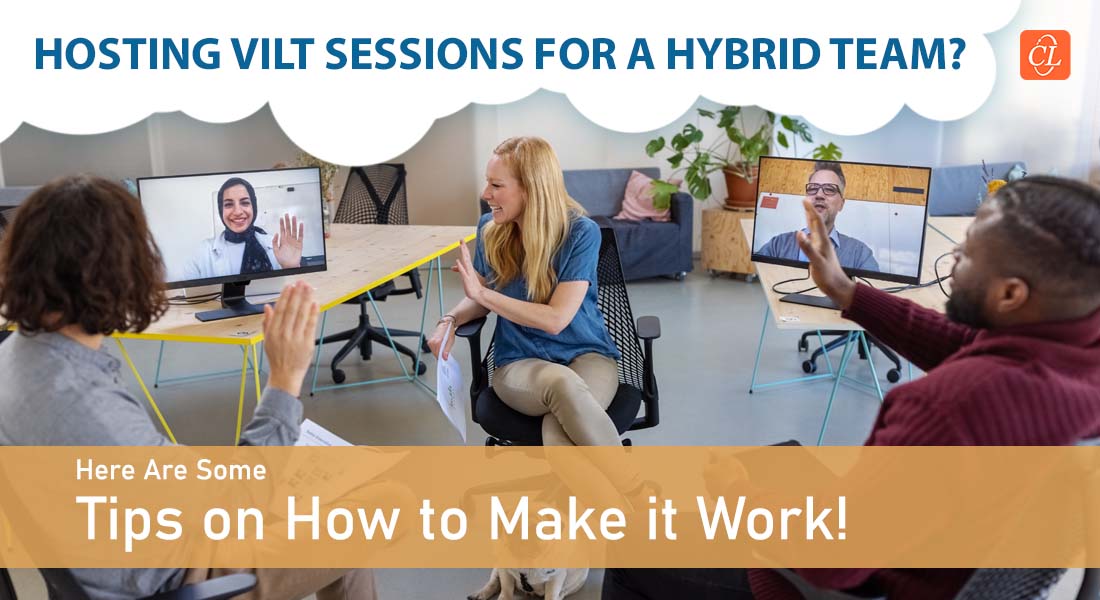Hosting VILT Sessions for a Hybrid Team – How to Make it Work

The COVID-19 pandemic pushed most of our activity online and significantly transformed training in the process. Although the function’s digital transformation had begun, lockdowns and social distancing mandates further increased its significance. This need led to the creation of VILT (Virtual Instructor-Led Training).
This new model of training has been surprisingly helpful. The initial shift to online instruction was sudden and haphazard, so there wasn’t enough awareness of or familiarity with technology. However, VILT emerged after the initial observation and is optimized for digital learning.
Managing a Hybrid Team in a VILT Session Isn’t an Easy Task
Here are some important ways to optimize your virtual instructor-led training sessions:
- Use Blended Learning Environment
- Encourage Participants to Engage Through Voice or Chat
- Use Breakout Room Feature
- Give Team-Based Tasks
- Engage Both Audiences
This blog will explain what VILT is, mention its benefits, and explore how you can use it for hybrid teams effectively.
What Is Virtual Instructor-Led Training?
Virtual Instructor-Led Training refers to training conducted virtually or through a simulated environment. Typically, the trainer and trainees aren’t always in the same location, prompting the need to connect digitally to prevent regional issues.
VILTs are meant to replicate real classrooms or training facilities but are optimized for the digital format. Technological advancement has played a central role in creating this solution, and academia is already using it for online courses.
Tips to Tailor VILT Sessions to Replicate the Human Interaction of the Classroom Training
What Are the Benefits of VILT?
VILT may have emerged due to the pandemic, but there is no doubt that it is a futuristic solution. Bridging our physical distances has been a major goal for technological innovation, and Virtual Instructor-Led Training furthers it.
Following are some of the most prominent benefits of adopting VILT for corporate training:
1. No Regional Barriers
The first benefit of VILT training is the lack of physical barriers. All participants connect through a digital tool, so they do not need to be in the same region to attend the session. This lack of barriers is critical for several reasons:
- It allows employees of a multinational in separate regions to attend the same training sessions.
- Prevents regional differences from leading to growth disadvantages.
- Allows people to attend the session from a convenient location, saving time.
2. Cost-Effective Solution
VILT is one of the most cost-effective solutions because it does away with much of the physical preparation. Organizations need to make physical arrangements for corporate training sessions, including setting up a room with tables, chairs, projectors, and similar tools.
For a VILT, participating parties only need to have the appropriate software installed on their PC. Hence, these training sessions save time and money.
3. Availability of Knowledge Retention Tools
The best part about virtual learning is that it provides access to several tools that enhance knowledge retention. The instructor can use dynamic imagery, videos, and creative demonstrations to maintain audience interest and explain the subject matter. These tools are often specially made for digital learning environments, so Virtual Instructor-Led Training can help you make the most of these elements.
4. Prompt Feedback
A core benefit of such learning structures is the immediate availability of feedback. Most exercises and activities are conducted in real-time so trainees can receive immediate guidance from the instructor. Additionally, sessions are also highly engaging, allowing everyone to participate. Such arrangements are generally beneficial and improve knowledge sharing and retention.
5. Flexible Arrangements
Flexibility is a major benefit of all online training sessions. Your employees can take the session from home, office, or any place they prefer so long as they have a PC and a connection. Similarly, the instructor is not obligated to conduct the session from a specific location.
These flexible arrangements are helpful for people who need to travel frequently or have personal responsibilities. It allows them to continue learning and improving without putting pressure on their routines.
What Are Hybrid Teams?
The pandemic was the primary reason everything shifted online, but things are changing again. The pandemic is somewhat under control leading several organizations to call employees back to the office. However, employees demand has increasingly led to establishing a hybrid workplace model, allowing teams to have flexibility.
The term hybrid team refers to teams in which some members work from home while others work from the office. Organizing training for such teams is a challenge due to their different arrangements, but it is possible with VILT sessions.
How to Optimize VILT for Hybrid Teams
Following are important ways to optimize your Virtual Instructor-Led Training sessions:
1. Use Blended Learning Environment
Blended learning environments create learning arrangements that mix online and offline audiences. Although it is challenging to establish balance, it isn’t impossible. The key is to organize two learning mechanisms, one suitable for online and another for offline.
Additionally, keep a virtual facilitator or coach who can ensure the lesson remains equally engaging and interactive for the remote audience. The in-person attendees benefit from interacting with the instructor one-on-one, so the facilitator will bridge this gap.
2. Encourage Participants to Engage Through Voice or Chat
It is critical to encourage your remote and in-person trainees to engage through voice or chat. This aspect is imperative because it will help both parties to feel equally involved and share their questions with the instructor. The more you engage them, the more actively they will listen and participate.
3. Use Breakout Room Feature
Most VILT software offers the breakout room feature to help trainers create separate virtual teams. The goal is to put people in groups and encourage them to find solutions and present. In a blended class, you can increase effectiveness by ensuring each breakout room has remote and on-site participants.
This arrangement will allow them to share their learning and opinions, benefiting from each other’s experiences. It will also ensure both groups communicate and learn how to work in hybrid settings.
4. Give Team-Based Tasks
Team-based tasks are vital for collaboration and helping people improve their social skills. You can make permanent groups for the training period or set up new teams for each task. The goal is to get them to interact, cooperate, plan, and execute plans and strategies together.
As with breakout rooms, you will need to ensure that these teams are a mix of remote and on-site trainees. Observe their interactions and provide necessary support if their communications stall due to the hybrid environment.
5. Engage Both Audiences
The most critical part of VILT is engaging both audiences equally well. There is always a chance that one group will suffer when you create different instruction formats, but you can fill in the gaps. Plan your lessons such that you have time pockets to address concerns for both parties separately.
The facilitator will minimize the gap as much as possible, but the instructor’s role is to ensure the gap doesn’t exist. Alternating between asking questions from both sections is a good way of maintaining balance and ensuring everyone gets clarity.
Wrapping Up
In a nutshell, Virtual Instructor-Led Training sessions are an incredible tool for facilitating online training and can be used for hybrid teams. The solution is to organize blended lessons with two different plans optimized for remote and on-site trainees. You must also facilitate both groups to prevent gaps in understanding and create blended teams to normalize hybrid structures. It is the best way to help employees adapt to the new normal. Are you ready to implement VILT in your organization? If yes! Check out this free eBook to get more insights and information on implementing VILT into your corporate training.





